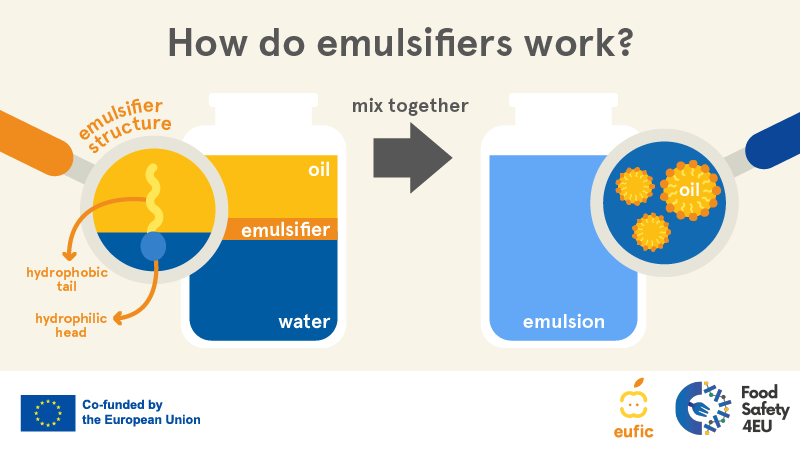The Role of Emulsifier In Food in Maintaining Freshness
Why It Is Necessary to Include an Emulsifier in Food for Optimal Preference and Quality
Emulsifiers play an essential function in food manufacturing by guaranteeing the secure blending of immiscible liquids, such as oil and water. They reduce interfacial stress, which prevents the separation of active ingredients and contributes to a consistent texture. This not just enhances mouthfeel however also affects taste perception. Recognizing the necessity of emulsifiers exposes deeper understandings right into their function and importance in culinary applications. What ramifications does this have for food innovation and consumer choices?
Understanding Emulsifiers: The Basics
Emulsifiers play a necessary function in food science, acting as agents that help with the mixing of 2 immiscible fluids, such as oil and water. These substances have both hydrophilic (water-attracting) and hydrophobic (water-repelling) residential properties, which allow them to maintain solutions. Common emulsifiers include lecithin, found in egg yolks and soybeans, and mono- and diglycerides, stemmed from fats.
The Science Behind Emulsification
When two immiscible liquids are combined, the process of emulsification becomes fundamental for achieving a stable mix. Emulsification includes distributing one fluid within an additional, usually oil in water or the other way around. This procedure happens with mechanical frustration, which damages the bigger beads into smaller ones, thus boosting the surface location. Without the presence of emulsifiers, these beads would certainly integrate, leading to separation.
Emulsifiers are molecules with hydrophilic (water-attracting) and hydrophobic (water-repelling) homes. Their distinct structure permits them to lower the interfacial stress between the two immiscible fluids, maintaining the solution. This stabilization prevents splitting up and improves the uniformity of appearance and flavor. The interactions at the molecular degree are crucial for keeping the stability of the emulsion, making certain that food preserve their desired uniformity and preference. Comprehending this science is significant for food scientists and manufacturers in developing premium foodstuff.
Types of Emulsifiers Utilized in Food
The kinds of emulsifiers utilized in food can be broadly categorized right into synthetic and all-natural varieties. Common food emulsifiers, such as lecithin and mono- and diglycerides, play an important function in boosting food stability and appearance. Comprehending these differences is necessary for appreciating exactly how emulsifiers add to the general top quality of food products.
All-natural vs. Synthetic Emulsifiers
While both artificial and natural emulsifiers offer the essential function of stabilizing blends in foodstuff, their attributes and origins vary markedly. All-natural emulsifiers, obtained from plant or animal resources, consist of lecithin, casein, and specific gums. They are usually viewed as healthier alternatives, appealing to consumers looking for clean-label items. In contrast, artificial emulsifiers, such as mono- and diglycerides, are chemically engineered and might offer improved stability and performance in a bigger series of applications. These synthetic choices can be extra cost-effective and offer constant top quality. They may stimulate apprehension amongst health-conscious customers. Eventually, the option in between natural and synthetic emulsifiers depends on the preferred top qualities of the food item, consisting of appearance, flavor, and shelf-life security.
Common Food Emulsifiers
Emulsifiers play a vital function in the food market, making sure the security and structure of numerous items. Usual food emulsifiers consist of lecithin, mono- and diglycerides, and polysorbates. Emulsifier In Food. Lecithin, originated from resources like soybeans and egg yolks, is commonly utilized in baked items and delicious chocolates. Mono- and diglycerides, often obtained from vegetable oils, improve the creaminess of margarine and ice cream. Polysorbates, artificial emulsifiers, are regularly located in salad dressings and sauces, promoting a smooth consistency. Other emulsifiers such as xanthan gum tissue and guar gum tissue, both natural thickeners, likewise add to the desired texture in various food. Each emulsifier kind serves certain functions, contributing to the overall top quality and charm of food items

Duty in Food Stability
Food stability is greatly affected by the kinds of emulsifiers made use of, which help avoid the separation of active ingredients in various formulations. Emulsifiers such as lecithin, mono- and diglycerides, and polysorbates play vital roles in preserving the harmony of items like dressings, sauces, and ice lotions. Lecithin, originated from soy or egg yolk, is specifically efficient as a result of its natural homes, while mono- and diglycerides boost texture and life span. Polysorbates, on the other hand, enhance the security of oil-in-water solutions, making them perfect for baked products. The selection of emulsifier relies on the particular food application and wanted characteristics, making certain that products stay secure, appealing, and of premium quality throughout their desired life span.
Exactly How Emulsifiers Improve Appearance and Mouthfeel
Enhancing the sensory experience of food, emulsifiers play a necessary role in boosting texture and mouthfeel. These materials help with the uniform circulation of ingredients, enabling a smoother and creamier uniformity in items such as dressings, sauces, and ice creams. By stabilizing mixtures of oil and water, emulsifiers protect against separation, leading to a natural structure that enhances the total eating experience.
Furthermore, emulsifiers can customize the viscosity of food, contributing to a desirable thickness or creaminess. This change of texture can affect how food feels in the mouth, influencing complete satisfaction and satisfaction. In addition, by developing a secure solution, emulsifiers aid preserve the honesty of the item, ensuring that the intended mouthfeel is regularly provided in time. Generally, the application of emulsifiers is vital for achieving the appropriate texture and mouthfeel, ultimately elevating the top quality of food items.
The Function of Emulsifiers in Flavor Enhancement
Taste enhancement in culinary applications frequently hinges on the reliable use emulsifiers. These substances help with the blending of water and oil, enabling the even distribution of flavor substances within food items. like this By creating secure solutions, emulsifiers help to envelop and launch volatile tastes, improving the overall sensory experience.
In enhancement, emulsifiers can boost the understanding of taste by affecting the mouthfeel and structure of meals. A smoother, more natural item can cause a heightened assumption of flavors, making them more pleasurable and pronounced. In addition, emulsifiers can safeguard sensitive flavors from degradation, making certain that they continue to be intact throughout handling and storage space.
Emulsifiers in Popular Food Products
Just how do emulsifiers add to the texture and stability of popular foodstuff? Emulsifiers play a crucial role in numerous extensively taken in items. In salad dressings, they assure a smooth blend of oil and vinegar, avoiding splitting up and improving mouthfeel. In ice cream, emulsifiers develop a creamy appearance by supporting air bubbles, causing a rich and indulgent product. Baked goods, such as bread and cakes, gain from emulsifiers by enhancing quantity and crumb structure, bring about a lighter and extra appealing texture. Additionally, mayo depends on emulsifiers to maintain its thick uniformity and avoid oil separation. Margarine and spreads also utilize emulsifiers to achieve a spreadable texture while preserving security. These examples highlight the substantial impact of emulsifiers on hop over to these guys the quality and satisfaction of everyday food products, emphasizing their significance in modern food formulation.
The Future of Emulsifiers in Food Advancement
The future of emulsifiers in food development is marked by substantial developments in modern technology, leading the way for new formulas. Furthermore, the demand for much healthier emulsifier choices is increasing, triggering researchers to discover plant-based and all-natural choices. Sustainable sourcing techniques are likewise ending up being important, as consumers significantly prioritize environmental duty in their food options.
Developments in Emulsifier Technology
As scientists remain to explore the molecular details of emulsifiers, considerable advancements are arising that pledge to revolutionize food technology. Current developments concentrate on producing more functional and effective emulsifiers that enhance structure, stability, and taste in various food items. Innovations in biopolymer-based emulsifiers are obtaining grip, offering enhanced sustainability and efficiency over standard alternatives. Furthermore, advancements in nanotechnology are enabling the design of emulsifiers at the molecular degree, which can lead to finer solutions and improved sensory experiences. These technical innovations are not just improving product top quality however additionally expanding the series of applications for emulsifiers in the food industry. As these innovations unfold, they are anticipated to redefine cooking possibilities and customer preferences in the future.
Healthier Emulsifier Alternatives
While traditional emulsifiers have actually played an important duty in food manufacturing, there is an expanding need for healthier choices that align with customer choices for clean tags and natural ingredients. Developments in plant-based emulsifiers, such as those stemmed from flaxseed, sunflower, and soy, have actually gotten appeal as a result of their perceived health benefits. These alternatives commonly consist of fewer additives and provide functionality comparable to artificial emulsifiers. In addition, components like aquafaba, the fluid from cooked chickpeas, have emerged as functional emulsifying agents, attracting vegan and health-conscious consumers. Emulsifier In Food. The change towards these healthier emulsifiers not just enhances the appeal of food however likewise sustains the fad of openness in component sourcing, ultimately fostering customer count on and complete satisfaction

Lasting Sourcing Practices
Sustainable sourcing methods are ending up being progressively crucial in the advancement of emulsifiers, reflecting a wider dedication to environmental duty within the food industry. Manufacturers are currently focusing on the use of eco-friendly sources, such as plant-based components, which reduces the carbon footprint related to typical emulsifiers. This change not just supports biodiversity yet additionally promotes honest farming practices that benefit local communities. Furthermore, developments in innovation allow the extraction and handling of emulsifiers with minimized ecological effect. By adopting sustainable sourcing, companies improve their brand name picture while fulfilling customer need for transparency and Click Here eco-friendliness. As the food sector continues to evolve, the combination of lasting emulsifiers will certainly play a crucial duty in shaping future technologies, ensuring an equilibrium in between quality and environmental stewardship.
Regularly Asked Questions
Are Emulsifiers Safe for People With Food Allergies?

Can Emulsifiers Influence the Nutritional Value of Food?
Emulsifiers can influence the dietary worth of food by enhancing vitamins and mineral absorption or potentially changing the bioavailability of specific substances. However, their effects vary extensively relying on the kind of emulsifier and the overall food formulation.
Just How Do Emulsifiers Effect Service Life of Products?
Emulsifiers boost the service life of items by maintaining mixtures, stopping splitting up, and lowering putridity. This security helps preserve structure and flavor gradually, ultimately ensuring food continues to be risk-free and appealing for longer durations.
What Are Typical All-natural Emulsifiers Found in Home Kitchens?
Common all-natural emulsifiers located in home kitchens consist of egg yolks, honey, mustard, and soy lecithin. These ingredients help stabilize combinations by minimizing surface area stress in between oil and water, improving texture and uniformity in different dishes.
Exist Any Kind Of Issues With Synthetic Emulsifiers in Food?
Problems concerning artificial emulsifiers in food include prospective digestive issues, inflammatory feedbacks, and web links to obesity. Some studies recommend these additives may disrupt intestine microbiota, increasing questions about their lasting results on health and wellness and well-being.
Common food emulsifiers, such as lecithin and mono- and diglycerides, play a crucial function in improving food stability and appearance. Emulsifiers play a necessary role in the food market, making certain the stability and appearance of numerous products - Emulsifier In Food. Various other emulsifiers such as xanthan gum and guar gum, both all-natural thickeners, also add to the preferred appearance in various food products. Current growths focus on developing a lot more versatile and reliable emulsifiers that boost appearance, security, and taste in different food products. Emulsifiers can pose dangers for individuals with food allergic reactions, as some emulsifiers are acquired from irritants like soy or eggs